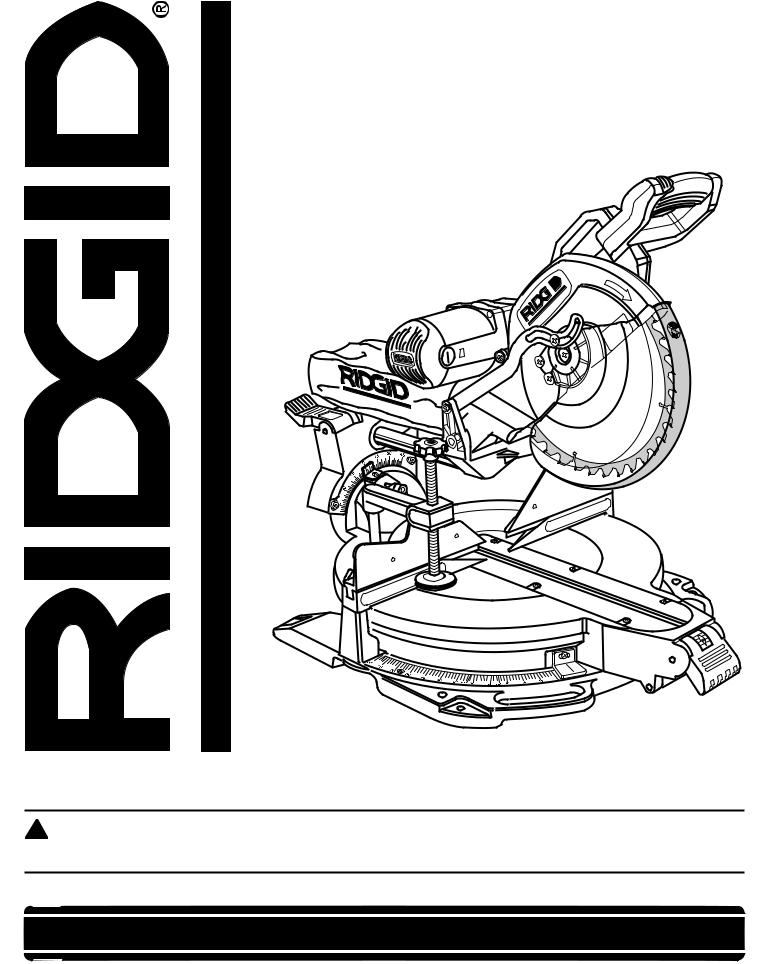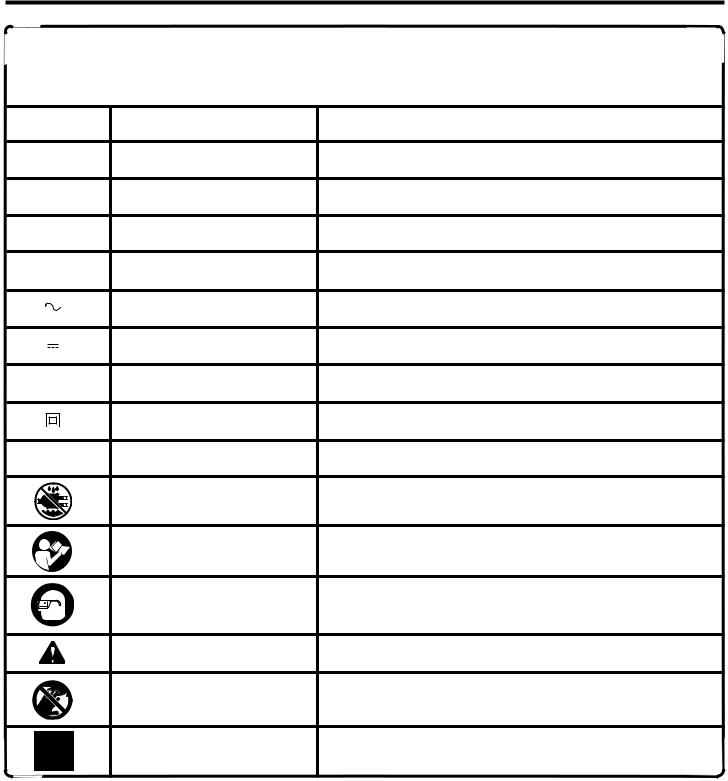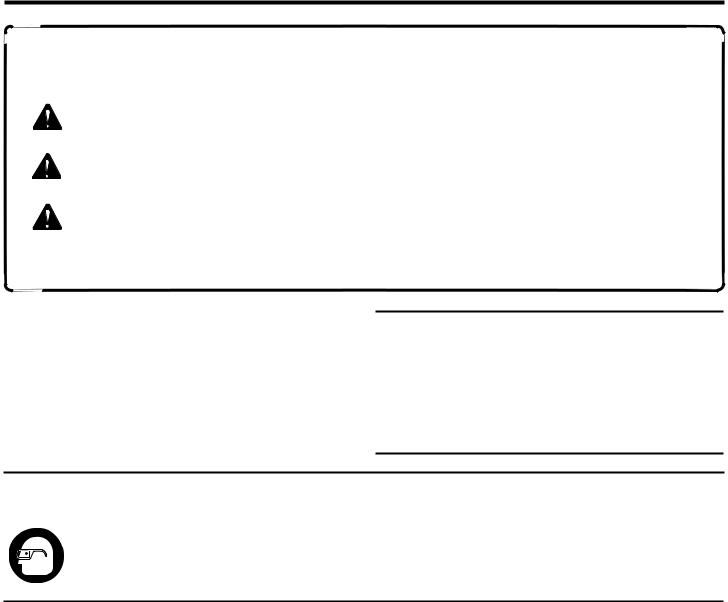RIDGID MS1290LZA User Manual

OPERATOR’S MANUAL
12 in. SLIDING COMPOUND MITER SAW WITH LASER
Double Insulated MS1290LZA
 ®
®
Your miter saw has been engineered and manufactured to our high standard for dependability, ease of operation, and operator safety. When properly cared for, it will give you years of rugged, trouble-free performance.
 WARNING:
WARNING:
To reduce the risk of injury, the user must read and understand the operator’s manual before using this product.
Thank you for buying a RIDGID® product.
SAVE THIS MANUAL FOR FUTURE REFERENCE

TABLE OF CONTENTS |
|
Introduction ...................................................................................................................................................................... |
2 |
General Safety Rules..................................................................................................................................................... |
3-4 |
Specific Safety Rules..................................................................................................................................................... |
4-5 |
Symbols......................................................................................................................................................................... |
6-7 |
Electrical ........................................................................................................................................................................... |
8 |
Glossary of Terms............................................................................................................................................................. |
9 |
Features..................................................................................................................................................................... |
10-12 |
Tools Needed ................................................................................................................................................................. |
13 |
Loose Parts..................................................................................................................................................................... |
14 |
Assembly ................................................................................................................................................................... |
15-24 |
Operation................................................................................................................................................................... |
25-35 |
Adjustments.................................................................................................................................................................... |
35 |
Maintenance.............................................................................................................................................................. |
36-37 |
Accessories .................................................................................................................................................................... |
38 |
Warranty ......................................................................................................................................................................... |
39 |
Parts Ordering/Service ................................................................................................................................................... |
40 |
INTRODUCTION |
|
This tool has many features for making its use more pleasant and enjoyable. Safety, performance, and dependability have been given top priority in the design of this product making it easy to maintain and operate.
2

GENERAL SAFETY RULES
 WARNING:
WARNING:
Read and understand all instructions. Failure to follow all instructions listed below, could result in electric shock, fire and/or serious personal injury.
READ ALL INSTRUCTIONS
KNOWYOURPOWERTOOL.Readtheoperator’smanual carefully. Learn the applications and limitations as well as the specific potential hazards related to this tool.
GUARDAGAINSTELECTRICALSHOCKBYPREVENTING BODY CONTACT WITH GROUNDED SURFACES.
For example: pipes, radiators, ranges, refrigerator enclosures.
KEEP GUARDS IN PLACE and in good working order.
REMOVE ADJUSTING KEYS AND WRENCHES. Form habitofcheckingtoseethatkeysandadjustingwrenches are removed from tool before turning it on.
KEEPWORKAREACLEAN.Clutteredareasandbenches invite accidents. DO NOT leave tools or pieces of wood on the tool while it is in operation.
DO NOT USE IN DANGEROUS ENVIRONMENTS. Do not use power tools in damp or wet locations or expose to rain. Keep the work area well lit.
KEEP CHILDREN AND VISITORS AWAY. All visitors should wear safety glasses and be kept a safe distance from work area. Do not let visitors contact tool or extension cord while operating.
MAKE WORKSHOP CHILDPROOF with padlocks, master switches, or by removing starter keys.
DON’T FORCE THE TOOL. It will do the job better and safer at the feed rate for which it was designed.
USE THE RIGHT TOOL. Do not force the tool or attachment to do a job for which it was not designed.
USETHEPROPEREXTENSIONCORD.Makesureyour extensioncordisingoodcondition.Useonlyacordheavy enough to carry the current your product will draw. An undersized cord will cause a drop in line voltage resulting in loss of power and overheating. A wire gauge size (A.W.G.) of at least 14 is recommended for an extension cord 25 feet or less in length. If in doubt, use the next heaviergauge.Thesmallerthegaugenumber,theheavier the cord.
DRESSPROPERLY.Donotwearlooseclothing,neckties, or jewelry that can get caught and draw you into moving parts. Rubber gloves and nonskid footwear are recommended when working outdoors. Also wear protective hair covering to contain long hair.
ALWAYS WEAR SAFETY GLASSES WITH SIDE SHIELDS. Everyday eyeglasses have only impactresistant lenses, they are NOT safety glasses.
SECUREWORK.Useclampsoravisetoholdworkwhen practical, it is safer than using your hand and frees both hands to operate the tool.
DONOTOVERREACH.Keepproperfootingandbalance at all times.
MAINTAIN TOOLS WITH CARE. Keep tools sharp and clean for better and safer performance. Follow instructions for lubricating and changing accessories.
DISCONNECTTOOLS.Whennotinuse,beforeservicing, orwhenchangingattachments,blades,bits,cutters,etc., all tools should be disconnected from power source.
AVOID ACCIDENTAL STARTING. Be sure switch is off when plugging in any tool.
USE RECOMMENDED ACCESSORIES. Consult the operator’s manual for recommended accessories. The use of improper accessories may result in injury.
NEVER STAND ON TOOL. Serious injury could occur if the tool is tipped.
CHECK DAMAGED PARTS. Before further use of the tool, a guard or other part that is damaged should be carefullycheckedtodeterminethatitwilloperateproperly and perform its intended function. Check for alignment of moving parts, binding of moving parts, breakage of parts, mounting and any other conditions that may affect its operation. A guard or other part that is damaged must be properly repaired or replaced by an authorized service center to avoid risk of personal injury.
USE THE RIGHT DIRECTION OF FEED. Feed work into a blade, cutter, or sanding spindle against the direction or rotation of the blade, cutter, or sanding spindle only.
NEVERLEAVETOOLRUNNINGUNATTENDED.TURN THE POWER OFF. Don’t leave tool until it comes to a complete stop.
PROTECT YOUR LUNGS. Wear a face or dust mask if the cutting operation is dusty.
PROTECT YOUR HEARING. Wear hearing protection during extended periods of operation.
DO NOT ABUSE CORD. Never carry tool by the cord or yank it to disconnect from receptacle. Keep cord from heat, oil, and sharp edges.
USE OUTDOOR EXTENSION CORDS. When tool is used outdoors, use only extension cords with approved ground connection that are intended for use outdoors and so marked.
KEEPBLADESCLEAN,SHARP,ANDWITHSUFFICIENT SET. Sharp blades minimize stalling and kickback.
BLADE COASTS AFTER BEING TURNED OFF.
3

GENERAL SAFETY RULES
NEVERUSEINANEXPLOSIVEATMOSPHERE.Normal sparking of the motor could ignite fumes.
INSPECT TOOL CORDS PERIODICALLY. If damaged, have repaired by a qualified service technician at an authorized service facility. The conductor with insulation havinganoutersurfacethatisgreenwithorwithoutyellow stripes is the equipment-grounding conductor. If repair or replacement of the electric cord or plug is necessary, do not connect the equipment-grounding conductor to a live terminal. Repair or replace a damaged or worn cord immediately. Stay constantly aware of cord location and keep it well away from the rotating blade.
INSPECT EXTENSION CORDS PERIODICALLY and replace if damaged.
POLARIZEDPLUGS.Toreducetheriskofelectricshock, this tool has a polarized plug (one blade is wider than the other). This plug will fit in a polarized outlet only one way. If the plug does not fit fully in the outlet, reverse the plug. If it still does not fit, contact a qualified electrician to install the proper outlet. Do not change the plug in any way.
KEEP TOOL DRY, CLEAN, AND FREE FROM OIL AND GREASE.Always use a clean cloth when cleaning. Never use brake fluids, gasoline, petroleum-based products, or any solvents to clean tool.
STAY ALERT AND EXERCISE CONTROL. Watch what you are doing and use common sense. Do not operate tool when you are tired. Do not rush.
DO NOT USE TOOL IF SWITCH DOES NOT TURN IT ON AND OFF. Have defective switches replaced by an authorized service center.
USE ONLY CORRECT BLADES. Do not use blades with incorrect size holes. Never use blade washers or blade bolts that are defective or incorrect. The maximum blade capacity of the saw is 12 in.
BEFORE MAKING A CUT, BE SURE ALL ADJUSTMENTS ARE SECURE.
BE SURE BLADE PATH IS FREE OF NAILS. Inspect for and remove all nails from lumber before cutting.
NEVER TOUCH BLADE or other moving parts during use.
NEVER START A TOOL WHEN ANY ROTATING COMPONENTISINCONTACTWITHTHEWORKPIECE.
DO NOT OPERATE A TOOL WHILE UNDER THE INFLUENCE OF DRUGS, ALCOHOL, OR ANY MEDICATION.
WHENSERVICINGuseonlyidenticalreplacementparts. Use of any other parts may create a hazard or cause product damage.
USE ONLY RECOMMENDED ACCESSORIES listed in this manual or addendums. Use of accessories that are not listed may cause the risk of personal injury. Instructions for safe use of accessories are included with the accessory.
DOUBLE CHECK ALL SETUPS. Make sure blade is tight and not making contact with saw or workpiece before connecting to power supply.
SPECIFIC SAFETY RULES
FIRMLY CLAMP OR BOLT the tool to a workbench or table at approximately hip height.
KEEP HANDS AWAY FROM CUTTING AREA. Do not reach underneath work or in blade cutting path with your handsandfingersforanyreason.Alwaysturnthepoweroff.
ALWAYSSUPPORTLONGWORKPIECESwhilecutting tominimizeriskofbladepinchingandkickback.Sawmay slip, walk, or slide while cutting long or heavy boards.
ALWAYS USE A CLAMP to secure the workpiece when possible.
BESURETHEBLADECLEARSTHEWORKPIECE.Never startthesawwiththebladetouchingtheworkpiece.Allow motor to come up to full speed before starting cut.
MAKESURETHEMITERTABLEANDSAWARMBEVEL FUNCTION) ARE LOCKED IN POSITION BEFORE OPERATINGYOURSAW.Lockthemitertablebysecurely tightening the miter lock lever. Lock the saw arm (bevel function) by securely tightening the bevel lock lever.
USE THIS SAW TO CUT WOOD, WOOD PRODUCTS, AND SOME PLASTICS ONLY. DO NOT CUT METALS, CERAMICS OR MASONRY PRODUCTS.
BEFORE MOVING THE SAW, unplug the saw then lock the miter, bevel, slide, and power head positions.
NEVER USE A LENGTH STOP ON THE FREE SCRAP END OF A CLAMPED WORKPIECE. NEVER hold onto or bind the free scrap end of the workpiece in any operation. If a work clamp and length stop are used together, they must both be installed on the same side of the saw table to prevent the saw from catching the loose end and kicking up.
NEVER cut more than one piece at a time. DO NOT STACK more than one workpiece on the saw table at a time.
NEVER PERFORM ANY OPERATION FREEHAND.
Always place the workpiece to be cut on the miter table and position it firmly against the fence as a backstop. Always use the fence.
4

SPECIFIC SAFETY RULES
NEVER hand hold a workpiece that is too small to be clamped. Keep hands clear of the cutting area.
NEVER reach behind, under, or within three inches of the blade and its cutting path with your hands and fingers for any reason.
NEVER reach to pick up a workpiece, a piece of scrap, or anything else that is in or near the cutting path of the blade.
AVOID AWKWARD OPERATIONS AND HAND POSITIONS where a sudden slip could cause your hand to move into the blade. ALWAYS make sure you have good balance. NEVER operate the miter saw on the floor or in a crouched position.
NEVER stand or have any part of your body in line with the path of the saw blade.
ALWAYSreleasethepowerswitchandallowthesawblade to stop rotating before raising it out of the workpiece.
DO NOT TURN THE MOTOR SWITCH ON AND OFF RAPIDLY. This could cause the saw blade to loosen and could create a hazard. Should this ever occur, stand clear and allow the saw blade to come to a complete stop. Disconnect the saw from the power supply and securely retighten the blade bolt.
IF ANY PART OF THIS MITER SAW IS MISSING or should break, bend, or fail in any way, or should any electrical component fail to perform properly, shut off the power switch, remove the miter saw plug from the powersourceandhavedamaged,missing,orfailedparts replaced before resuming operation.
IF THE POWER SUPPLY CORD IS DAMAGED, it must be replaced only by the manufacturer or by an authorized service center to avoid risk.
ALWAYS STAY ALERT! Do not allow familiarity (gained from frequent use of your saw) to cause a careless mistake. ALWAYS REMEMBER that a careless fraction of a second is sufficient to inflict severe injury.
MAKE SURE WORK AREA HAS AMPLE LIGHTING to see the work and that no obstructions will interfere with safe operation BEFORE performing any work using your saw.
ALWAYS TURN OFF THE SAW before disconnecting it to avoid accidental starting when reconnecting to power supply.NEVERleavethesawunattendedwhileconnected to a power source.
THIS TOOL has the following markings:
a)Wear eye protection.
b)Keep hands out of path of saw blade
c)Do not operate saw without guards in place.
d)Do not perform any operation freehand.
e)Never reach around saw blade.
f)Turn off tool and wait for saw blade to stop before moving workpiece or changing settings.
g)Disconnect power (or unplug tool as applicable) before changing blade or servicing.
h)No load speed.
ALWAYS MAKE SURE THE SAW BLADE HAS CLEARANCE OF ALL OBSTRUCTIONS BEFORE TURNING THE SAW ON.
MAKE SLIDING CUTS by pushing the saw blade down on top of the workpiece then sliding it back toward the rear of the saw. DO NOT pull the saw toward you while making a cut.
ALWAYS carry the tool only by the carrying handles.
AVOID direct eye exposure when using the laser guide.
THIS SAW CAN TIP OVER if the saw head is released suddenly and the saw is not secured to a work surface. ALWAYS secure this saw to a stable work surface before any use to avoid serious personal injury.
SAVETHESEINSTRUCTIONS.Refer to them frequently and use to instruct other users. If you loan someone this tool, loan them these instructions also.
 WARNING:
WARNING:
Some dust created by power sanding, sawing, grinding, drilling, and other construction activities contains chemicals known to cause cancer, birth defects or other reproductive harm. Some examples of these chemicals are:
•lead from lead-based paints,
•crystalline silica from bricks and cement and other masonry products, and
•arsenic and chromium from chemically-treated lumber.
Your risk from these exposures varies, depending on how often you do this type of work. To reduce your exposure to these chemicals: work in a well ventilated area, and work with approved safety equipment, such as those dust masks that are specially designed to filter out microscopic particles.
5

SYMBOLS
Some of the following symbols may be used on this tool. Please study them and learn their meaning. Proper interpretation of these symbols will allow you to operate the tool better and safer.
SYMBOL |
NAME |
DESIGNATION/EXPLANATION |
V |
Volts |
Voltage |
A |
Amperes |
Current |
Hz |
Hertz |
Frequency (cycles per second) |
W |
Watt |
Power |
min |
Minutes |
Time |
|
Alternating Current |
Type of current |
|
Direct Current |
Type or a characteristic of current |
no |
No Load Speed |
Rotational speed, at no load |
|
Class II Construction |
Double-insulated construction |
.../min |
Per Minute |
Revolutions, strokes, surface speed, orbits etc., per minute |
|
Wet Conditions Alert |
Do not expose to rain or use in damp locations. |
|
Read The Operator’s Manual |
To reduce the risk of injury, user must read and understand |
|
operator’s manual before using this product. |
|
|
|
|
|
Eye Protection |
Always wear safety goggles or safety glasses with side shields and, |
|
as necessary, a full face shield when operating this product. |
|
|
|
|
|
Safety Alert |
Precautions that involve your safety. |
|
No Hands Symbol |
Failure to keep your hands away from the blade will result in |
|
serious personal injury. |
|
|
|
|
|
Hot Surface |
To reduce the risk of injury or damage, avoid contact with any |
|
hot surface. |
|
|
|
6

SYMBOLS
The following signal words and meanings are intended to explain the levels of risk associated with this product.
SYMBOL |
SIGNAL |
MEANING |
|
|
DANGER: |
Indicates an imminently hazardous situation, which, if not avoided, will |
|
|
result in death or serious injury. |
||
|
|
||
|
|
|
|
|
WARNING: |
Indicates a potentially hazardous situation, which, if not avoided, could |
|
|
result in death or serious injury. |
||
|
|
||
|
|
|
|
|
CAUTION: |
Indicates a potentially hazardous situation, which, if not avoided, may |
|
|
result in minor or moderate injury. |
||
|
|
||
|
|
|
|
|
CAUTION: |
(Without Safety Alert Symbol) Indicates a situation that may result in |
|
|
property damage. |
||
|
|
||
SERVICE
Servicing requires extreme care and knowledge and should be performed only by a qualified service technician. For service we suggest you return the product to your nearest
AUTHORIZED SERVICE CENTER for repair. When servicing, use only identical replacement parts.
 WARNING:
WARNING:
To avoid serious personal injury, do not attempt to use this product until you read thoroughly and understand completely the operator’s manual. If you do not understand the warnings and instructions in the operator’s manual, do not use this product. Call RIDGID® customer service for assistance.
 WARNING:
WARNING:
The operation of any power tool can result in foreign objects being thrown into your eyes, which can result in severe eye damage. Before beginning power tool operation, always wear safety goggles or safety glasses with side shields and, when needed, a full face shield. We recommend Wide Vision Safety Mask for use over eyeglasses or standard safety glasses with side shields. Always use eye protection which is marked to comply with ANSI Z87.1.
SAVE THESE INSTRUCTIONS
7

ELECTRICAL
DOUBLE INSULATION
Double insulation is a concept in safety in electric power tools, which eliminates the need for the usual three-wire grounded power cord. All exposed metal parts are isolated from the internal metal motor components with protecting insulation. Double insulated tools do not need to be grounded.
 WARNING:
WARNING:
The double insulated system is intended to protect the user from shock resulting from a break in the tool’s internal wiring. Observe all normal safety precautions to avoid electrical shock.
NOTE: Servicing of a product with double insulation requires extreme care and knowledge of the system and should be performed only by a qualified service technician. For service, we suggest you return the tool to your nearest authorized service center for repair. Always use original factory replacement parts when servicing.
ELECTRICAL CONNECTION
This tool has a precision-built electric motor. It should be connected to a power supply that is 120 volts, 60 Hz, AC only (normal household current). Do not operate this tool on direct current (DC). A substantial voltage drop will cause a loss of power and the motor will overheat. If the tool does not operate when plugged into an outlet, double-check the power supply.
EXTENSION CORDS
When using a power tool at a considerable distance from a power source, be sure to use an extension cord that has the capacity to handle the current the product will draw. An undersized cord will cause a drop in line voltage, resulting in overheating and loss of power. Use the chart to determine the minimum wire size required in an extension cord. Only round jacketed cords listed by Underwriter’s Laboratories (UL) should be used.
When working outdoors with a product, use an extension cord that is designed for outside use. This type of cord is designated with “WA” on the cord’s jacket.
Before using any extension cord, inspect it for loose or exposed wires and cut or worn insulation.
**Ampere rating (on product data plate) |
|
|
|
|||
|
0-2.0 |
2.1-3.4 3.5-5.0 |
5.1-7.0 |
7.1-12.0 |
12.1-16.0 |
|
|
|
|
|
|
||
Cord Length |
|
Wire Size (A.W.G.) |
|
|
||
|
|
|
|
|
|
|
25' |
16 |
16 |
16 |
16 |
14 |
14 |
|
|
|
|
|
|
|
50' |
16 |
16 |
16 |
14 |
14 |
12 |
|
|
|
|
|
|
|
100' |
16 |
16 |
14 |
12 |
10 |
— |
**Used on 12 gauge - 20 amp circuit.
NOTE: AWG = American Wire Gauge
 WARNING:
WARNING:
Keep the extension cord clear of the working area. Position the cord so that it will not get caught on lumber, tools, or other obstructions while you are working with a power tool. Failure to do so can result in serious personal injury.
 WARNING:
WARNING:
Check extension cords before each use. If damaged replace immediately. Never use tool with a damaged cord since touching the damaged area could cause electrical shock resulting in serious injury.
8

GLOSSARY OF TERMS
Anti-Kickback Pawls (radial arm and table saws)
A device which, when properly installed and maintained, is designed to stop the workpiece from being kicked back toward the front of the saw during a ripping operation.
Arbor
The shaft on which a blade or cutting tool is mounted.
Bevel Cut
A cutting operation made with the blade at any angle other than 90° to the table surface.
Chamfer
A cut removing a wedge from a block so the end (or part of the end) is angled rather than at 90°.
Compound Cut
A cross cut made with both a miter and a bevel angle.
Cross Cut
A cutting or shaping operation made across the grain or the width of the workpiece.
Cutter Head (planers and jointer planers)
A rotating cutterhead with adjustable blades or knives. The blades or knives remove material from the workpiece.
Dado Cut
A non-through cut which produces a square-sided notch or trough in the workpiece (requires a special blade).
Featherboard
A device used to help control the workpiece by guiding it securely against the table or fence during any ripping operation.
FPM or SPM
Feet per minute (or strokes per minute), used in reference to blade movement.
Freehand
Performing a cut without the workpiece being guided by a fence, miter gauge, or other aids.
Gum
A sticky, sap-based residue from wood products.
Heel
Alignment of the blade to the fence.
Kerf
The material removed by the blade in a through cut or the slot produced by the blade in a non-through or partial cut.
Kickback
A hazard that can occur when the blade binds or stalls, throwing the workpiece back toward operator.
Leading End
The end of the workpiece pushed into the tool first.
Miter Cut
A cutting operation made with the workpiece at any angle to the blade other than 90°.
Non-Through Cuts
Any cutting operation where the blade does not extend completely through the thickness of the workpiece.
Push Blocks (for jointer planers)
Device used to feed the workpiece over the jointer planer cutterhead during any operation. This aid helps keep the operator's hands well away from the cutterhead.
Push Blocks and Push Sticks (for table saws)
Devices used to feed the workpiece through the saw blade during cutting operations. A push stick (not a push block) should be used for narrow ripping operations. These aids help keep the operator's hands well away from the blade.
Pilot Hole (drill presses)
A small hole drilled in a workpiece that serves as a guide for drilling large holes accurately.
Resaw
A cutting operation to reduce the thickness of the workpiece to make thinner pieces.
Resin
A sticky, sap-based substance that has hardened.
Revolutions Per Minute (RPM)
The number of turns completed by a spinning object in one minute.
Ripping or Rip Cut
A cutting operation along the length of the workpiece.
Riving Knife/Spreader/Splitter (table saws)
A metal piece, slightly thinner than the blade, which helps keep the kerf open and also helps to prevent kickback.
Saw Blade Path
The area over, under, behind, or in front of the blade. As it applies to the workpiece, that area which will be or has been cut by the blade.
Set
The distance that the tip of the saw blade tooth is bent (or set) outward from the face of the blade.
Snipe (planers)
Depression made at either end of a workpiece by cutter blades when the workpiece is not properly supported.
Through Sawing
Any cutting operation where the blade extends completely through the thickness of the workpiece.
Throw-Back
The throwing back of a workpiece usually caused by the workpiece being dropped into the blade or being placed inadvertently in contact with the blade.
Workpiece or Material
The item on which the operation is being done.
Worktable
Surface where the workpiece rests while performing a cutting, drilling, planing, or sanding operation.
9

FEATURES
PRODUCT SPECIFICATIONS
Blade Diameter.......................................................... |
12 in. |
Arbor Hole .................................................................... |
1 in. |
No Load Speed ..................................... |
4,000 r/min. (RPM) |
Input ................................ |
120 V, 60 Hz, AC Only, 15 Amps |
Net Weight................................................................ |
70 lbs. |
Cutting Capacity with Miter at 0°/Bevel 0°: |
|
Maximum nominal lumber sizes:.................... |
2 x 12, 4 x 4 |
Cutting Capacity with Miter at 45°/Bevel 0°: |
|
Maximum nominal lumber sizes:.............................. |
2 x 10 |
Cutting Capacity with Miter at 0°/Bevel 45°: |
|
Maximum nominal lumber sizes:.............................. |
2 x 12 |
DEPTH CONTROL KNOB |
CORD STORAGE |
|
BLADE WRENCH
STORAGE DUST
BAG
BEVEL
LOCK
LEVER
|
|
SWITCH |
|
|
LOCK |
SLIDE |
CARRYING |
“D” HANDLE |
LOCK KNOB |
|
|
|
HANDLE |
|
UPPER BLADE |
|
|
GUARD |
|
SWITCH |
|
|
|
|
|
TRIGGER |
|
® |
|
|
|
LOWER BLADE |
|
|
GUARD |
SLIDE BAR |
|
|
|
BEVEL |
|
|
|
STOP PIN |
|
|
ZERO CLEARANCE |
|
|
|
THROAT PLATE |
SLIDING MITER |
|
|
|
FENCE |
|
|
MITER |
|
|
|
|
FENCE |
|
|
THUMBWHEEL |
|
|
|
|
SCREW |
|
|
|
WORK |
|
|
|
CLAMP |
|
|
|
MITER |
|
FRONT |
MITER LOCK |
|
LEVER |
||
TABLE |
MITER |
CARRYING HANDLE |
|
|
SCALE |
SAW BASE |
Fig. 1 |
10

FEATURES
KNOW YOUR COMPOUND MITER SAW
See Figure 1.
The safe use of this product requires an understanding of the information on the tool and in this operator’s manual as well as a knowledge of the project you are attempting. Before use of this product, familiarize yourself with all operating features and safety rules.
12 IN. BLADE
A 12 in. blade is included with your compound miter saw. It will cut materials up to 13-1/2 in. wide, depending upon the angle at which the cut is being made.
15 AMP MOTOR
This saw has a powerful 15 amp motor with sufficient power to handle tough cutting jobs. It is made with all ball bearings, and has externally accessible brushes for ease of servicing.
BEVEL LOCK LEVER
The bevel lock lever securely locks your compound miter saw at desired bevel angles. Pulling the lever forward will release the saw allowing the blade to be tilted either left or right for bevel cuts. Pushing the lever back will lock the saw in place.
BEVEL STOP PIN
The bevel stop pin has two positions:
1.Override (pin pulled completely out)
2.The 0° - 48° position for crown molding (pin pushed in)
CARRYING HANDLES
See Figure 2.
Carrying handles are located on the top of the saw arm and on the front of the saw base.
To transport: turn off and unplug the saw; lower saw arm and lock it in the down position; lock bevel and miter lock levers; lock slide lock knob.
DEPTH CONTROL KNOB
When loosened, the depth control knob allows the user to adjust the depth guide then holds the guide securely in place when the knob is retightened.
NOTE: It is not necessary to loosen the knob when locking or unlocking the saw arm.
DEPTH GUIDE
See Figure 2.
The depth guide is used for locking the saw arm in the down position or as a guide for limiting downward movement of the saw arm.
NOTE: Controlling depth of cut is necessary when rough cutting a dado.
ELECTRIC BRAKE
An electric brake quickly stops blade rotation after the switch trigger is released.
LASER GUIDE
For more accurate cuts, a laser guide is included with your miter saw. When used properly, the laser guide makes accurate, precision cutting simple and easy.
CARRYING |
LOCK |
HANDLE |
PIN |
 DEPTH
DEPTH


 GUIDE FRONT
GUIDE FRONT 

CARRYING
HANDLE
SAW ARM LOCKED IN DOWN POSITION
Fig. 2
SWITCH
TRIGGER

SPINDLE
LOCK BUTTON
Fig. 3
11

FEATURES
MITER LOCK LEVER
The miter lock lever securely locks the saw at the desired miter angle.
MITER SCALE
The miter scale has index points provided at 0°, 15°, 22.5°, 31.6°, 45°, and 60.°
MITER THUMBWHEEL
The miter thumbwheel, when used with the miter lock lever lifted (unlocked), can release the miter table from pre-set index points. With the thumbwheel spun down (and released), the miter table moves freely to any desired angle. With thumb on thumbwheel, push down and hold to override (bypass) index points; release thumbwheel when close to desired point and move the lock lever into place with a click. With the thumbwheel spun up, the miter table will stop at each index point on the miter scale.
REPEAT-A-CUT™
See Figure 5.
The Repeat-A-Cut™ feature on both the left and right side miter fences can be used when making repetitive cuts. Simply mark the fence with a pencil, make the desired number of cut(s), then wipe the mark off with a soft cloth.
SELF-RETRACTING LOWER BLADE GUARD
The lower blade guard is made of shock-resistant, seethrough plastic that provides protection from each side of the blade. It retracts over the upper blade guard as the saw is lowered into the workpiece.
SLIDE BAR
When unlocked, the saw arm will glide forward and backward the length of the slide bar for cutting various workpiece widths.
SLIDE LOCK KNOB
The slide lock knob locks and unlocks the sliding feature of this tool.
SLIDING MITER FENCES
The sliding miter fences provided with this saw help hold the workpiece securely when making most cuts. The sliding feature allows for clearance of the saw blade when making bevel or compound cuts. Some cuts may require that the sliding fence be removed completely to avoid interference between the fence and the blade.
Loosen the fence screw before attempting to slide the fences or lift them for removal. Once the desired position of the fence is determined, retighten the fence screw securely.
SPINDLE LOCK BUTTON
See Figure 3.
A spindle lock button has been provided for locking the spindle (keeping the saw blade from turning). Depress and hold the lock button only while installing, changing, or removing the saw blade.
SWITCH TRIGGER
See Figure 4.
The saw will not start until you depress the switch lock with your thumb then squeeze the switch trigger. To prevent unauthorized use of the compound miter saw, disconnect it from the power supply and lock the switch in the OFF position. To lock the switch, install a padlock (not included) through the hole in the switch trigger. A lock with a long shackle up to 9/32 in. diameter may be used. When the lock is installed and locked, the switch is inoperable. Store the padlock key in another location.
SWITCH LOCK
PADLOCK 


SWITCH
TRIGGER
Fig. 4
REPEAT-A-CUT |
® |
SLIDE 







BAR
SLIDING |
|
MITER FENCE |
Fig. 5 |
12
